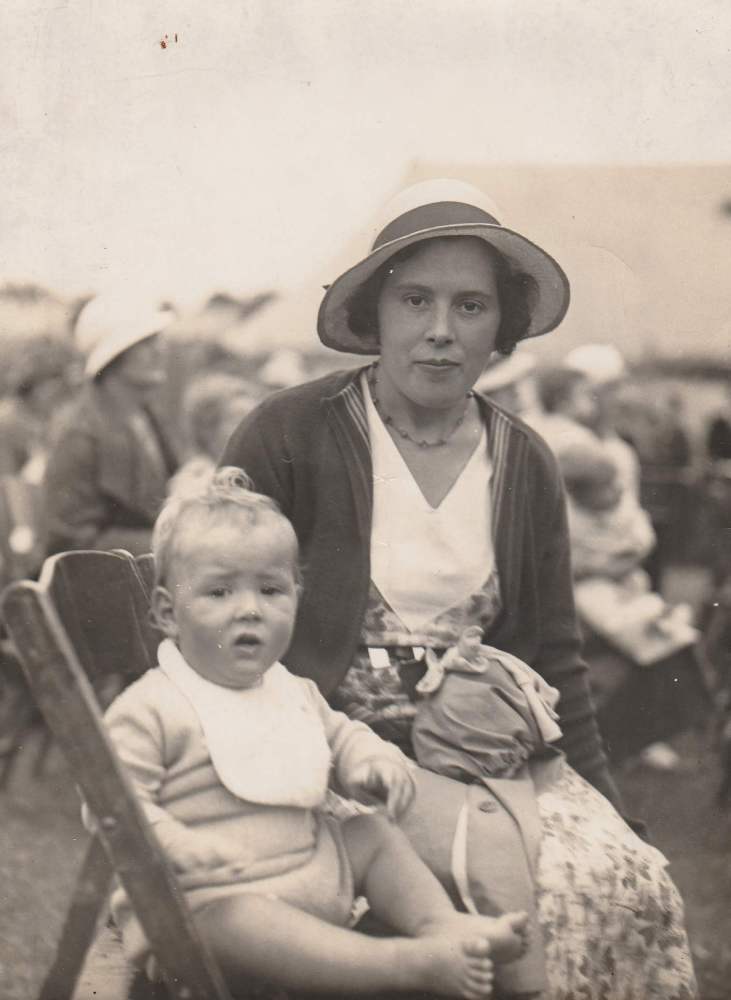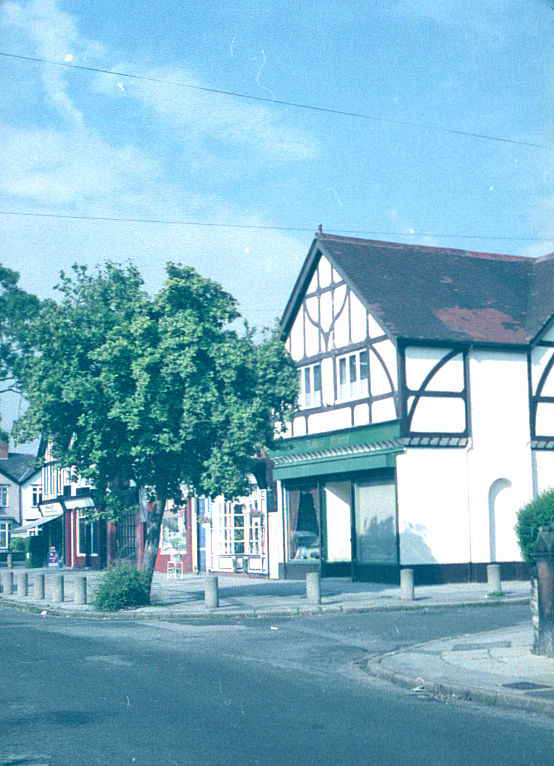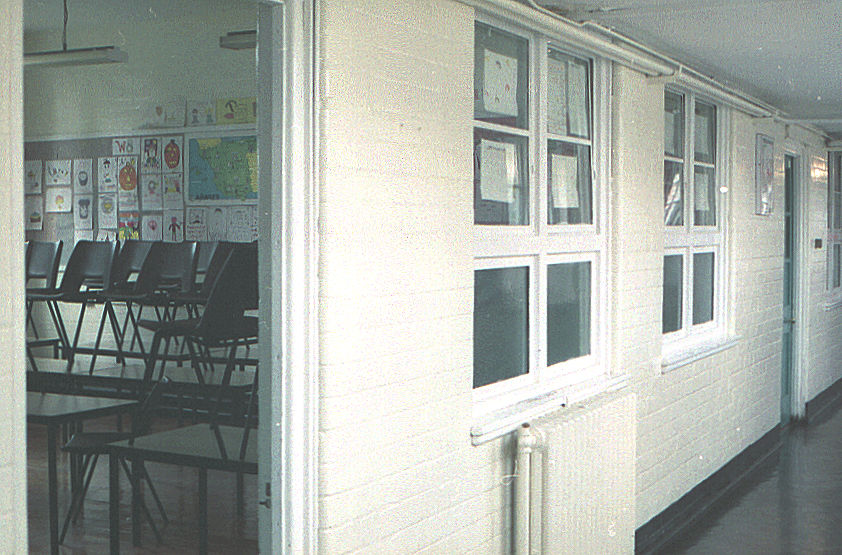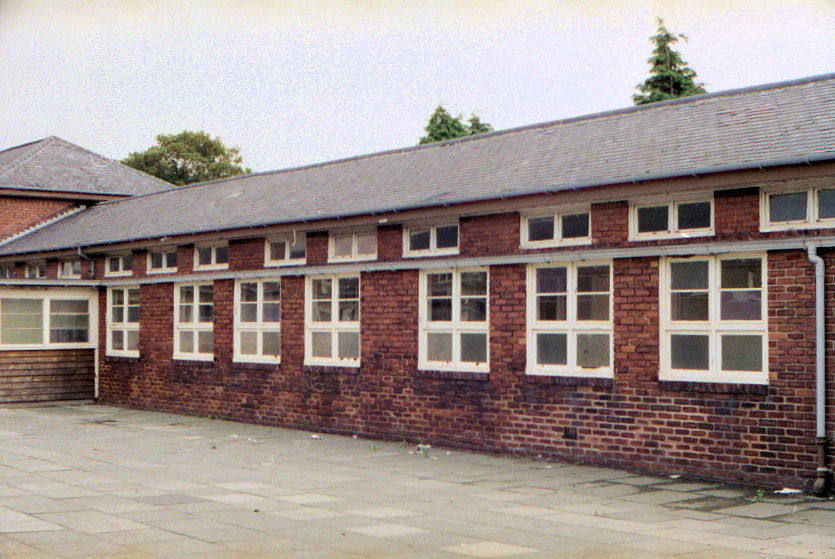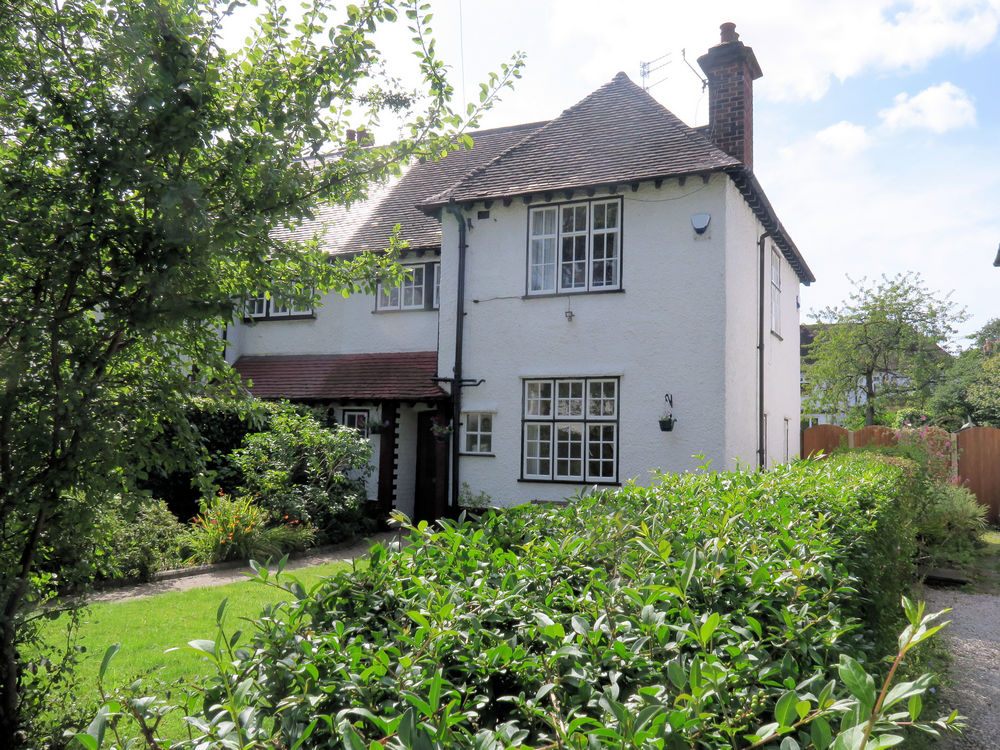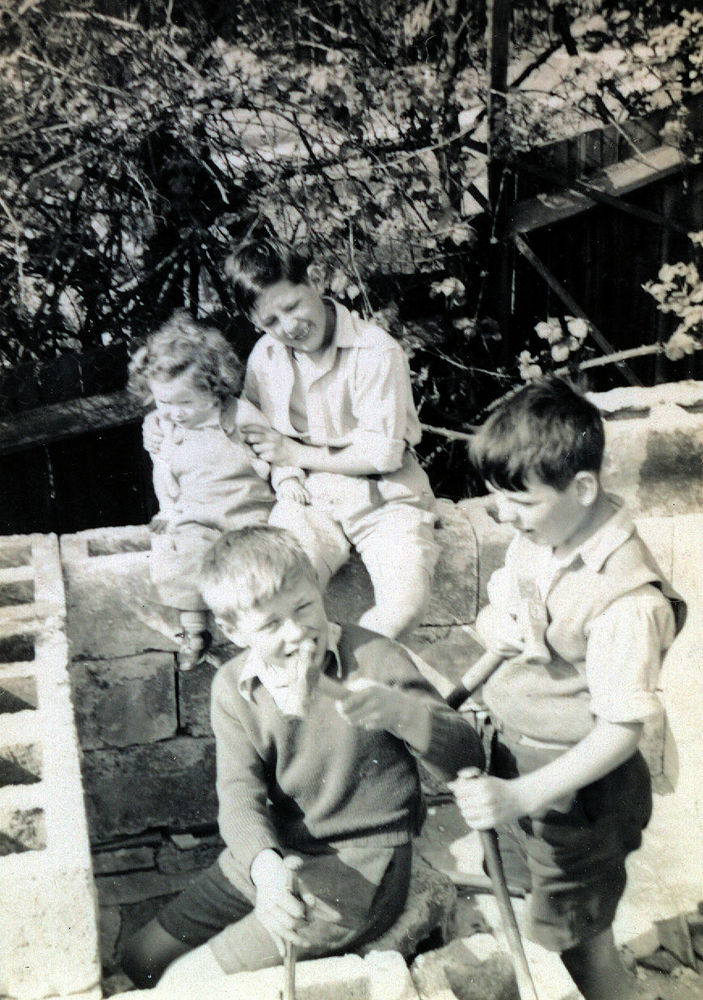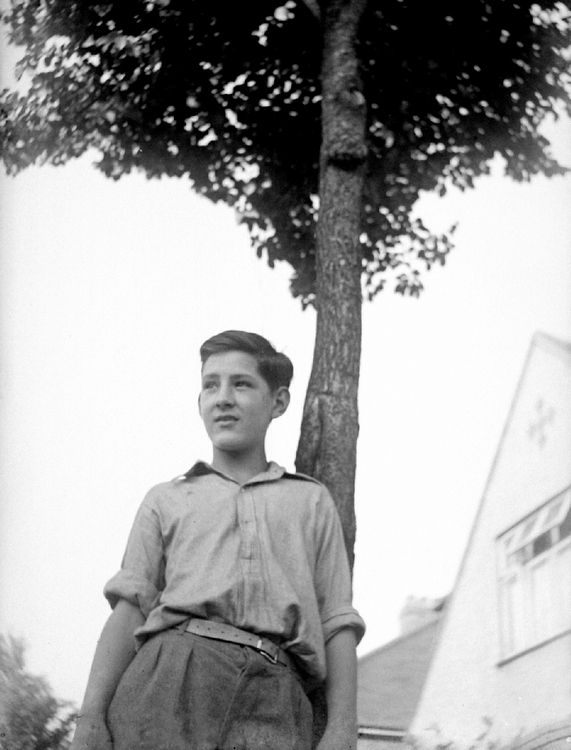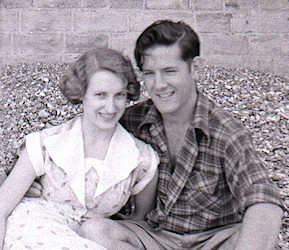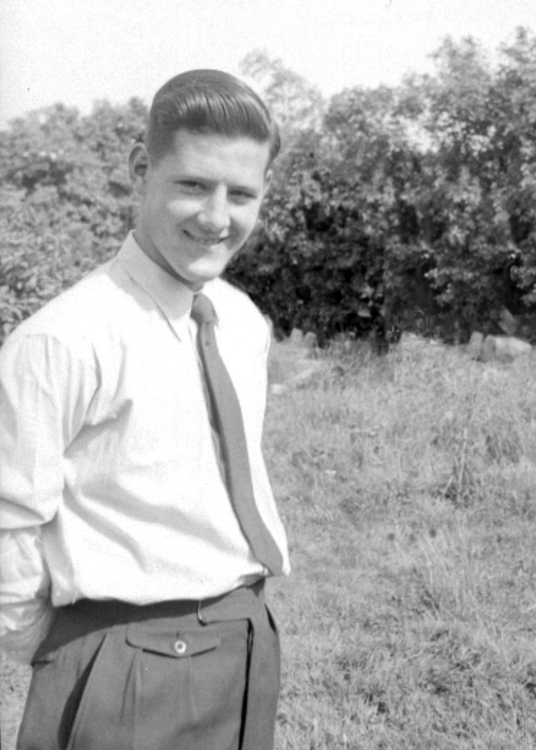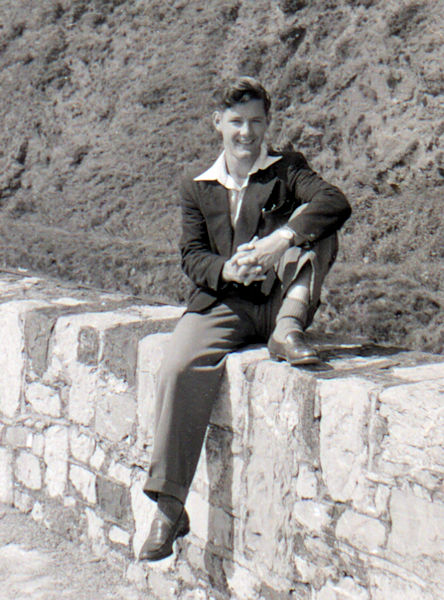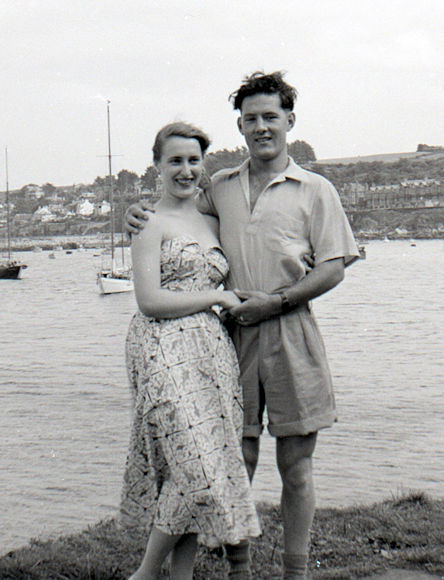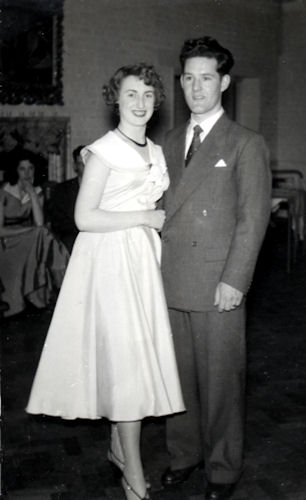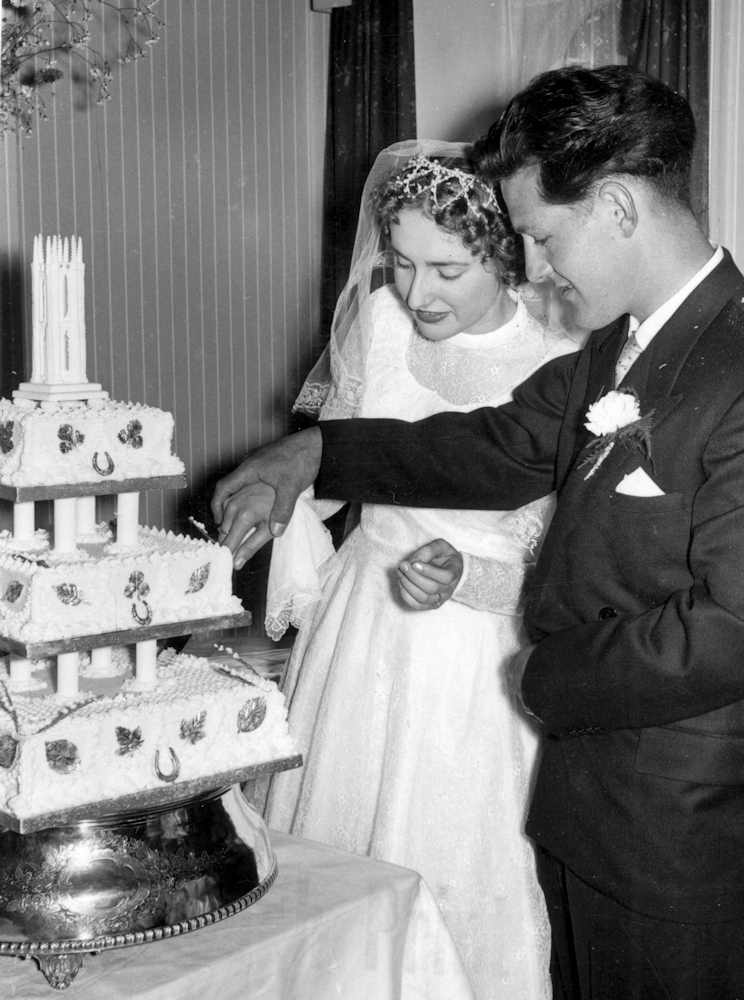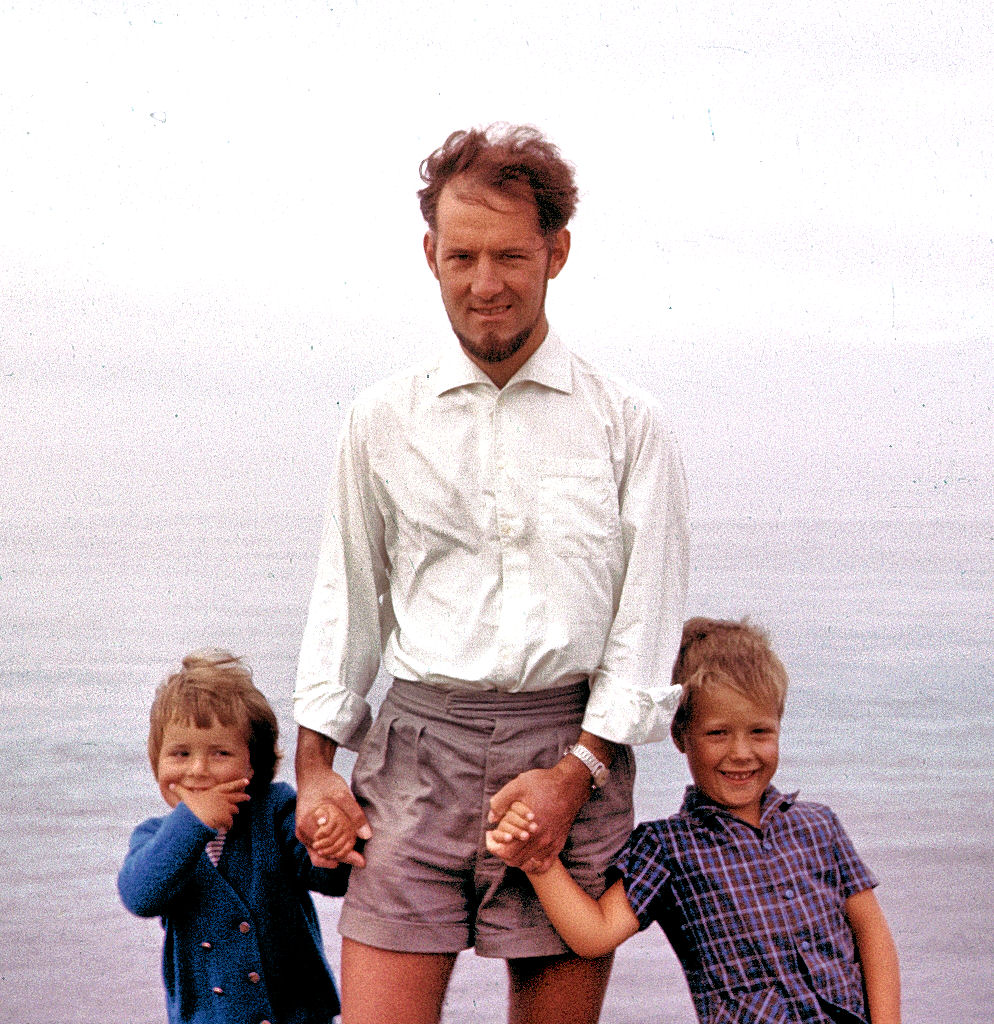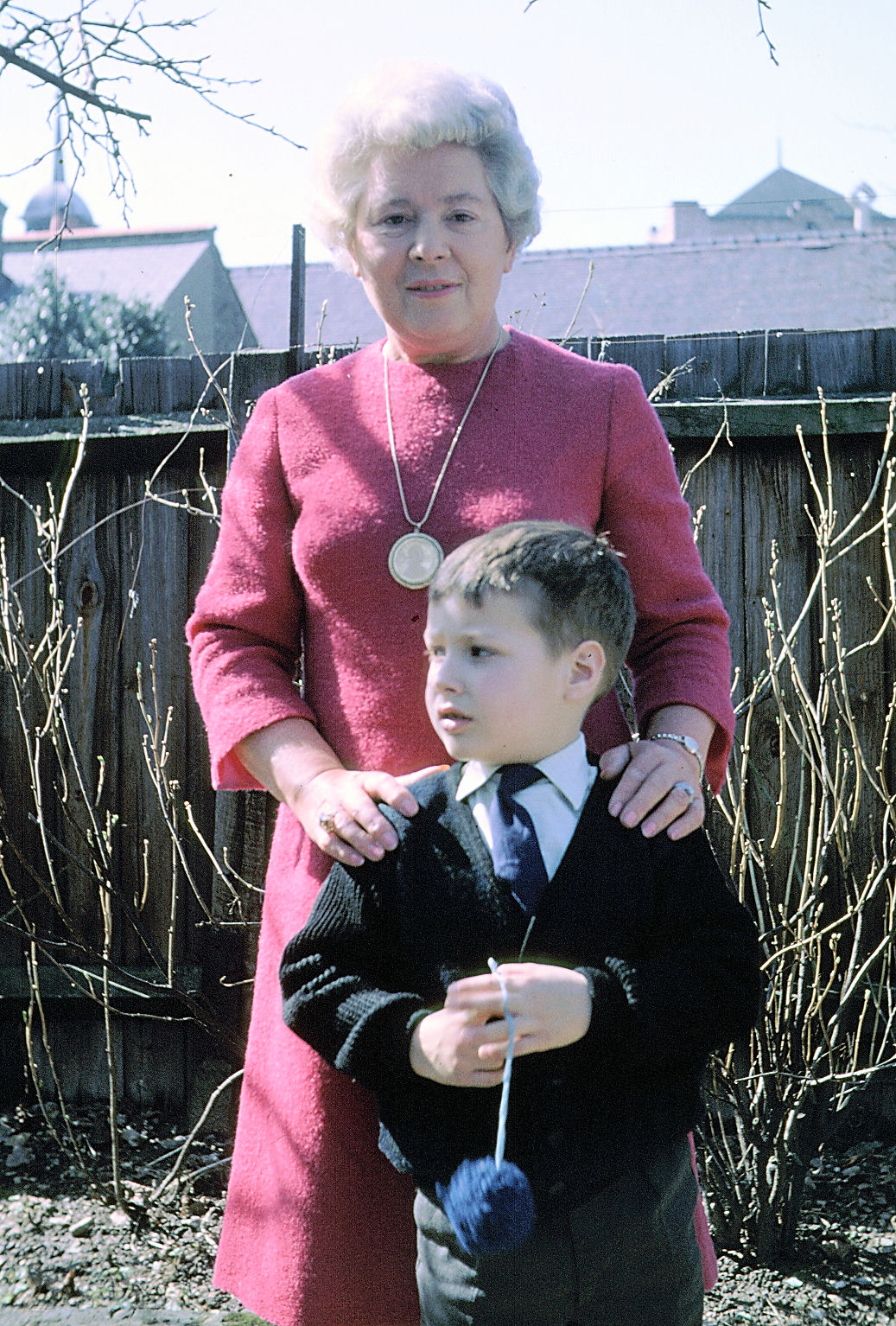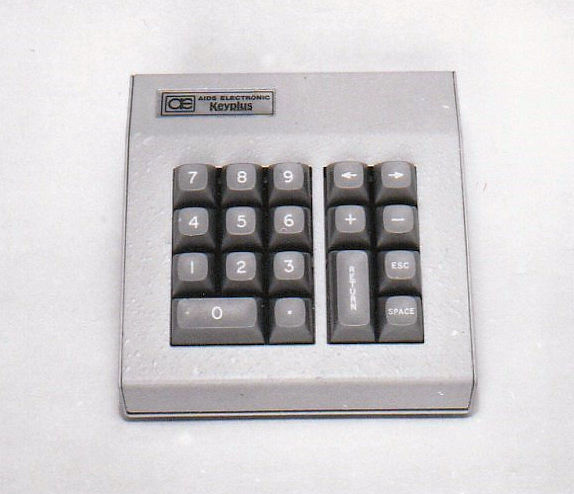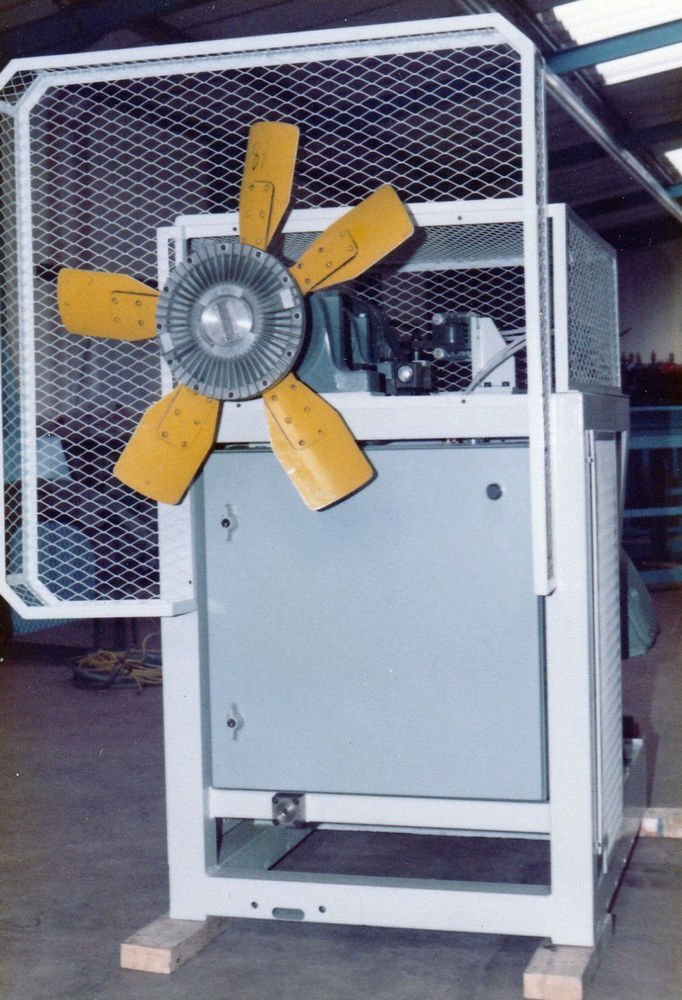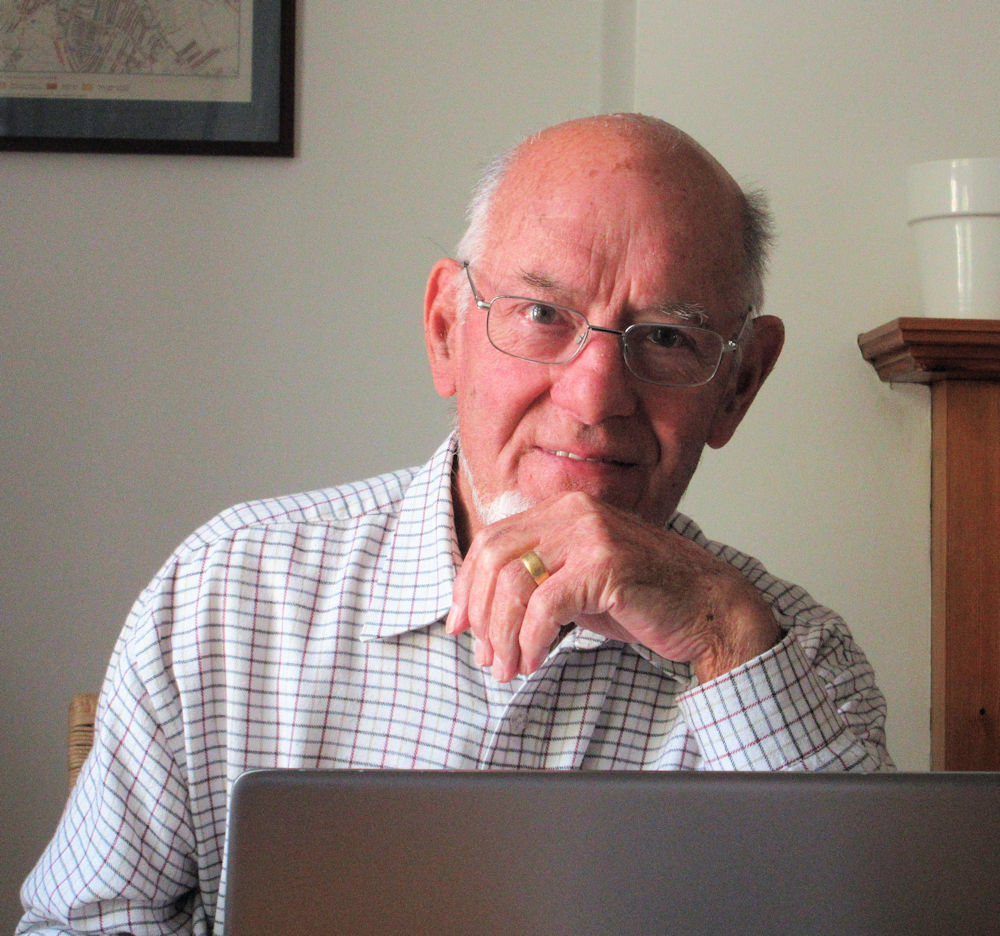David John Kinna born, 09-05-1933.
Pam E E Baldock b 13-6-1935, d 03-12-2017 m 18-6-55.
As a child I new that the Kinna name must be special, there were no other Kinna's in my school. I did not know of any other Kinna families until I was about 10 or 11, when we had a visit from Ken, my fathers second cousin. My father never talked about his parents or his early life. It was not until 2018 did I realize that there were surviving descendants in Russia of Rachel's family.
I was born at Bromley Maternity Hospital in Westmorland Road at about 2am. We lived at 9 Sandringham Road Bromley Kent and we referred to the house in later times as 'Sandringham'. One of my earliest memories is of Big Nana, my father's mother Rachel, reading to me from a book in the shape of an Eton Boy. I don't remember her face or her voice only her black skirt, I was probably about 3 at the time. Although Big Nana lived with us, there is only one photograph of her with me,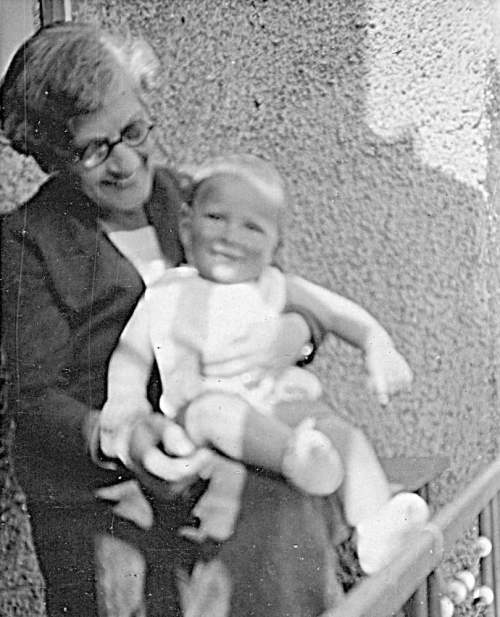
Big Nana died 6th March 1937 and I remember standing by the fire in her bedroom while my mother was making the bed. The fire was a free-standing black cast iron stove with two doors and mica windows. I was piggling the intricate shape of the side of the fire and asked where Big Nana had gone, and was told 'She's gone to Bournemouth'. This was true, for she is buried there in the Wimborne Road Cemetery.
My mother's sister Ivy married Jack Pearce in July 1937. We must have driven over to Little Nana's that day, they were living at Bathurst Gardens at the time, and I remember mummy showing me what was her bedroom before she married. I was to be a page boy and remember having my Page Boy outfit put on, in the Car on the way to the church, I think it was Dorothy, Jacks sister, who was dressing me, she was also one of the brides maids.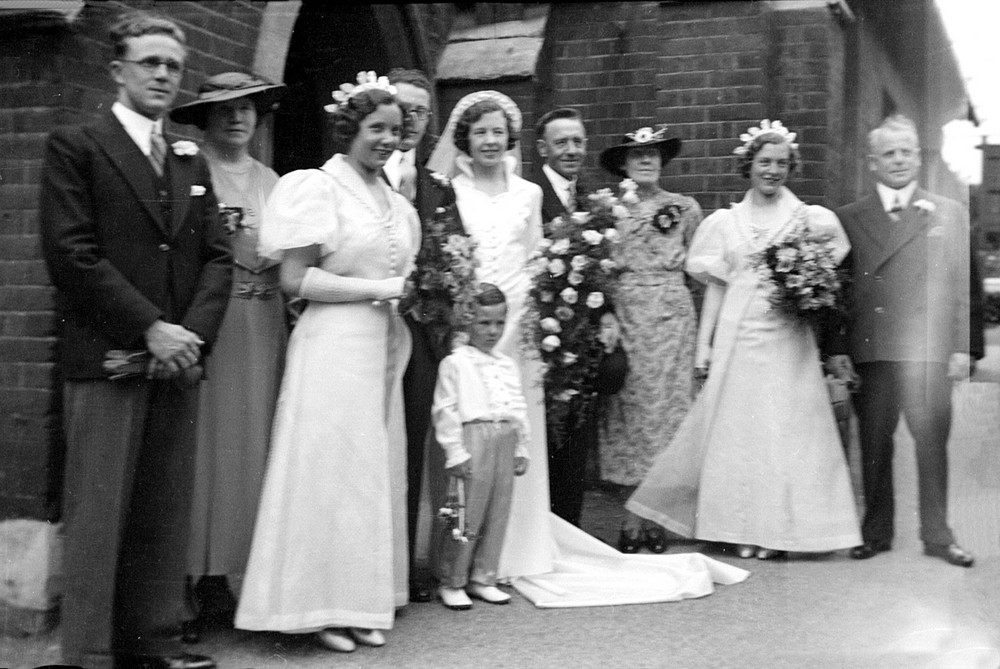
September 1938 Burnt Ash Infants/Junior community School. I walked to and from school twice a day every day, it was about a mile. On one such day probably winter 1938, I got home and my mother was appalled by the state of my new overcoat, she took me back to school in the afternoon, apparently another boy had taken my coat and I had just taken the one that was left. It all turned out satisfactorily.I don't have any memory of lessons but I remember break time, we had a bottle of milk, I think it cost 2d a week, and the teacher sold ‘Lyons Buzz’ at a penny. The Buzz was a chocolate covered biscuit in a green wrapper.
No sooner had I started school it seemed, the school was closed whilst the playground was dug up for air raid shelters. During this time groups of children were taught in individual homes, I remember children coming to our house, and my father provided a blackboard on his painting easel but I don’t remember going to other houses but I suppose I did. The school reopened on the 11th March 1940.
September 1939 My War - War was declared, it was hot day, the brown velvet curtains were drawn in the back room and I was running in and out, pushing through the curtains each time. My father had been digging a shelter at the bottom of the garden, it must have been very hard work, it was solid London clay. When the announcement came over the radio both my parents went in to listen, and I was told to stop running in and out. After the announcement the siren went, it was just a test I suppose. In the digging of the shelter, a land drainage pipe had been revealed, and some time later I had taken a hammer to it, unbeknown to my father. When it rained next time the shelter became flooded, my father was cross!. He did try to pump it out but the hand pump made little impact and the task was finally abandoned and the shelter filled in.
As an interim measure, my father took off some of the doors in the house and made a shelter with them in the back room. I think this must have been during the early part of the war, before the battle of Britain. I remember one night we were all lying on the floor under the doors, I was not sleeping and my father read to me from the Russian Bible and then translated it. I was enthralled by the sound of the Russian language although I don't remember what he read. I now sometimes wonder if it perhaps, it was for his benefit as much as mine.
Soon after the reopening of the school the council constructed a short cut, through the Water Board field, to school which cut the distance by about half. I think it is still open. We were told that if the siren went, while we were on the way to school, we were to run home or to school depending how far we had got, I don't remember this happening.
Aunty Brown, [ not a real aunt] who lived next door at number 7, had an Anderson shelter fitted and early on we used it as well. My father cut a hole in the fence to make the rout to the shelter easy and I can remember being carried to the shelter one night by my father and waking up in the morning in the shelter. During the battle of Britain I would try and watch, standing at the entrance to the shelter, I could hear the sound of the aircraft guns and see the vapour trails of the fighters and the squadrons of German aircraft.
We were given the choice of a Morrison shelter, or blast walls. We chose to have the kitchen made into a blast proof room. Blast proofing meant having large walls constructed very close to each of the windows, the back door and the front door. The walls were constructed from large hollow concrete blocks filled with sand. The windows were covered with netting, which was varnished in place. My Father built bunk beds for Gordon and my self but my parents slept on the floor.
When my brother started school he was only 4, and of course I had to take him to school. My memory is of a little boy dressed in a blue siren suit standing limp, as I tried to remove the suit. Inevitably I would be late, but my teacher, Mrs Baldry I think, did not think too much of my excuse, she would say 'just get up earlier'.
May 1940 I had a bicycle for my seventh birthday, 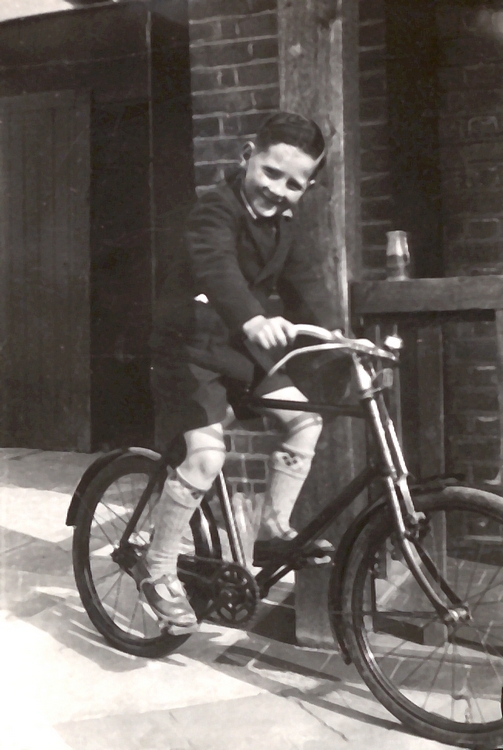
April 1941 On he night of the 16/17th April the blitz came to Bromley, the first big bomb hit the 700 year old Parish Church, 
We were moved out again later in the war because of an unexploded bomb at the bottom of the garden. In this case we went to stay with Mrs Robinson, I think she had been a friend of my grandmother, Rachel, I don't remember her husband he was always away in Archangel North Russia. Subsequently I used to visit her once a week after school, we would have tea and she would read to me from the Water Babies.
Paper, like many things, was short and so most of our school exercise books were rather poor quality. The Head Master, Mr Yelland, still had some pre-war books left and so when you needed a new book you had to go to the Head. If your work was very good you got a pre-war book. When it was my turn, I was given a recycled book and a note to summon my mother to an interview. The Head was very concerned about my spelling and writing, and my mother was told to see that I read more at home. He selected a book from his bookcase and gave it to her saying 'this will be a good start', it was This England by J B Prestley. He just did not understand my problem.
At Christmas time the school held a Christmas Show put on by the boys and staff. My father had the idea that I should do a turn - magic. He set about teaching me a number of tricks, burning a 10/- note, making shillings appear from space, Water into wine and back etc. On the whole they went down well although it was difficulty to get a 10/- note from the audience. The only other turn I remember was a Dyson, a boy from my class, he played the piano accordion. Watching the show was the school caretaker, a member of the ARP. The ARP were also putting on a Christmas show and they asked both Dyson and I to take part, I can’t remember much about it, but I did my magic. I was also recruited by a local concert party and we did several shows in the area. Gordon was also involved, he was in a sketch in which he sang ‘For me and my Girl’ with a little girl whose name I can’t remember, I think this must have been about 1943 and Gordon would have been about 6.
I remember going with my father to register for call-up, the Drill Hall, it was crowded with men waiting to see two of three officials sitting at trestle tables. Ultimately my father was considered to be in a reserved occupation and so did not go into the forces but he did do fire watching and became a member of the Home Guard. Fire watching meant that he would be stay at work all night in case of an air raid and subsequent fire, luckily there were no fires or damage to the works.
My mother worked part time for Sunlife of Canada, may be 11 to 5, any way it meant Gordon and I had our mid day meal at home by our selves, I would have a plate of Bovril and toast cut in to small squares. Some times we would go round to the Civic Restaurant and Gordon would have soup and I would have the steamed pudding and custard. This was not always possible, because there was a rule which said ‘no pudding without a main course’, but there was a nice blond lady on the cash desk on certain days, who would ignore the rule.
January 1943 I was sitting in the kitchen having lunch, when I heard aircraft coming, I looked out of the window and saw a German fighter passing over next door at roof top height. I could see the pilot in his helmet he was so close. There had been no warning. When I got back to school every body had seen the fighters. one boy said that he had nearly been killed by the machine gun fire, but the teacher said ‘either you were killed or you were not killed you could not be nearly killed’ I think the comment was lost on the class. When my father got home that night, he said that the school at the back of his works had been hit with a lot of children killed. [On 20th January 1943, in a lunchtime raid by German fighters on London, they hit Sandhurst School killing 6 teachers and 38 children.]
May 1943 My father joined the Home Guard, the 51st Kent Battalion number 3025. The Home Guard took up an evening and Sunday mornings. My father was issued a rifle and 10 rounds, these were kept under his bed.
June 1944 One night my father got me up to see this plane with fire coming out of it's tail, it was the first V1.
The nearest V1 to us passed over our house and landed about half a mile north of us on the Downham Estate. I was in the garden one lunchtime and had seen the doodlebug coming, it appeared to be heading straight for us, and then the engine cut out. I ran in to the kitchen and we crouched under the table, it seemed an age before we heard the swish as it passed overhead and then seconds later the explosion. I remember seeing the V1’s coming over and watching fighters chasing them.
Some of my friends had been evacuated at the beginning of the war, but my parents declined the opportunity. But with the coming of the V1’s Gordon and I were packed off up north. We spent the first week or so in Runcorn staying with the Dawson’s (Aunty Brown’s brother I think). It was not a very happy time for Gordon initially and I don’t think the Dawson’s felt they could cope with 2 boys and their own daughter, Ann.
On or about the 8th of August I went to stay with Aunty Ivy and Uncle Jack who had rooms in Mr Whale's house, 31 Wavertree Nook Road, I did not like him.
December 1944
Highfield School was a local authority school set up 1934 on the site of the demolished Highfield House, a Georgian Mansion. Laterly it became Highfield Comprehensive which became Broadgreen Community Comprehensive in 1985.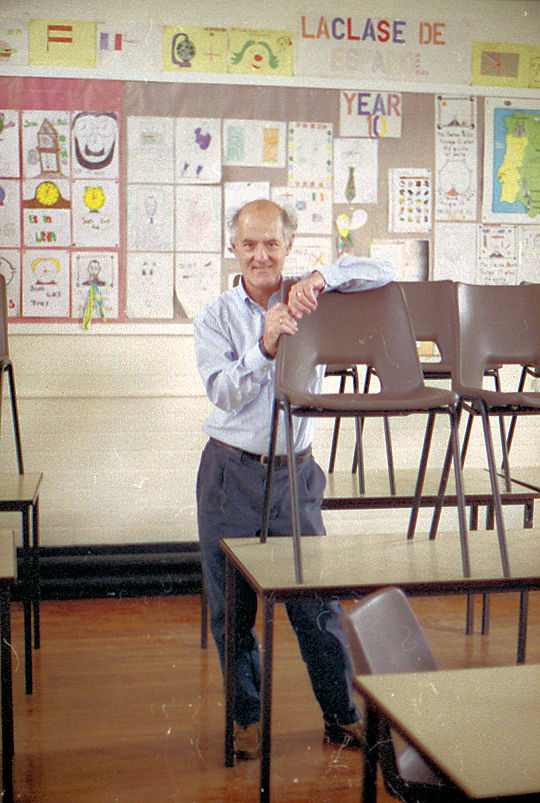
When Pam I went back in 1985 to see the school it was still as I rembered it, and we walked round even the class room seemed to be the same. We also went back to the house, that looked well maintained but the corner shops had changed although they were still there. The corner shop had been a Co-Op and above there had been a dance hall it was now 'Roberta Fabrics'.
One of my first journeys in to the city was to visit the Maccano Factory in Binns Road, when I got there I was most disappointed it was just a typical factory entrance, I don't know what I was expecting.
I was into collecting engine numbers at this time, and I would go down to Edge Hill and sit on the bridge parapet and watch the trains, when the trains came through we would get the benefit of the smoke and steam. No body ever said any thing to us about how dangerous it was. I think that I also went train spotting when I was in Runcorn, I remember sitting on the bank of a small cutting. The access was through a cornfield and we would pick a corn head, roll it in our hands and then blow away the husks and eat the rest. I went for a ride on one occasion on the 4A tram. When I got off, I walked round the area which was very run down and poor, children running about barefoot, a little girl in just a light dress, I had no idea that such poverty existed, Wavertree where I lived was built as a garden city.
I would take the tram to the pier head and get the ferry over to New Brighton, I think the best bit was the ferry ride. New Brighton had a large sandy beach when the tide was out otherwise there was no beach at all. I also went over to Birkenhead once, but that very much an industrial area.
I became friendly with a boy a year older than me I only remember him as King. On our way to school he used to smoke and he gave me American Gum. King had an older sister who went out with the US airmen from the local air base.
He took me to the only professional football game I have seen. Liverpool v Everton, I only remember the kicking and fouls, but we did have the banana-flavoured gum. The other attraction he had was his train layout, it took up most of one of the rooms. When I went there I can’t remember seeing anybody else in the house, but it was quite big and cold. As the days got shorter we would go out in the evening and play Truth Dare or Promise in the doorway of the Co-Op, or for a change play nock down ginger or getting a penn'orth of chips from the Chippy. There seemed to be four or five of us, one boy was Frances who lived two door down, a couple of girls whose names I don’t remember. As soon as the sun went down it was absolutely dark because of the blackout restrictions but just before Christmas the restrictions were to be relaxed and the street lamps on the main road were to be turned on. On the appointed day I went up to Queens Drive to see the lights come on.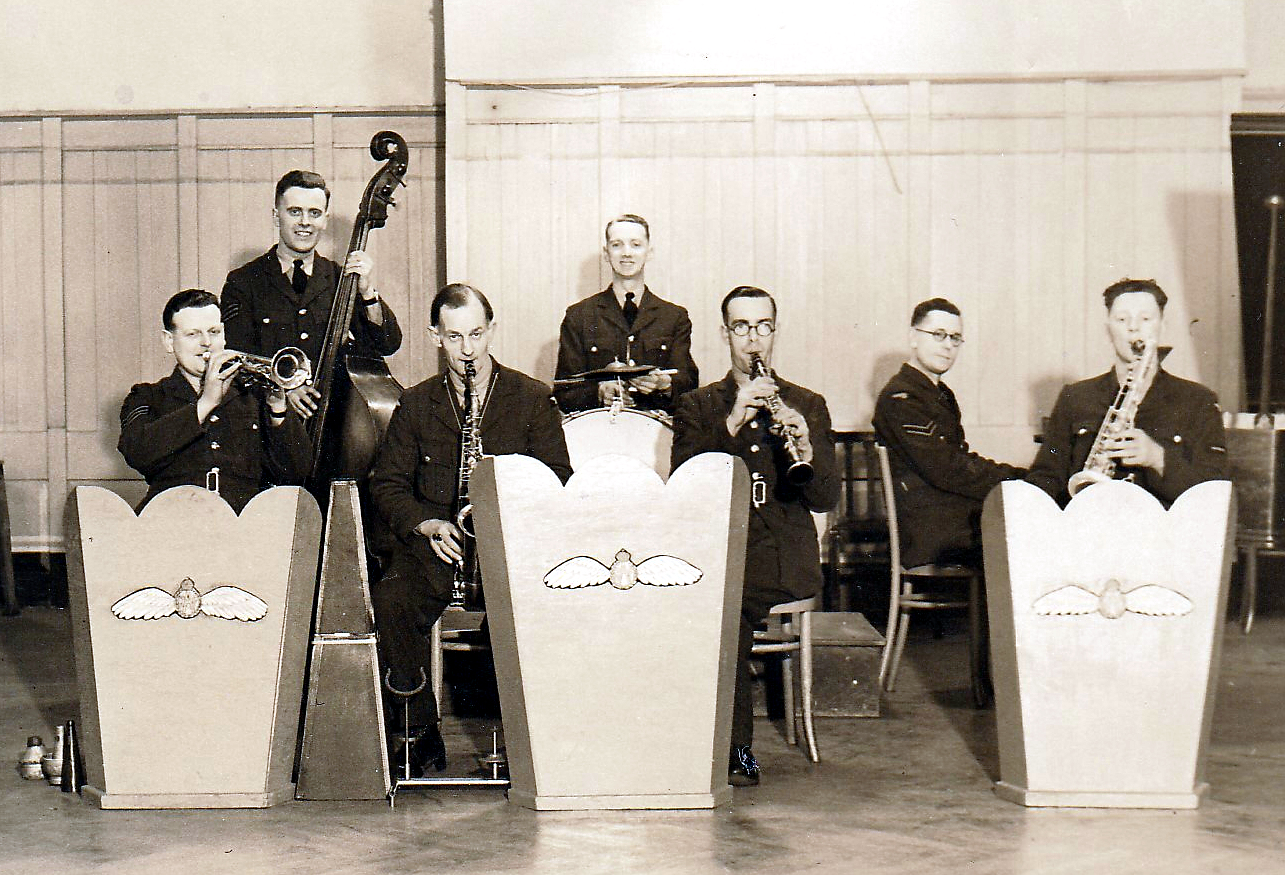
My mother came up just before Christmas to take us home and she was appalled by our scouse accents. I returned to Bromley, the V1's had reduced in number but by September 1944 the v2's had started. I was siting in class and apparently not paying attention, the teacher asked what I was doing and I answered I was listening to the Rockets coming, he said you can't hear them until they land. What I could hear was the sonic bang as it passed, seconds before the explosion.
VE day was 8th May 1945, I remember being in the park when the Church bells began to ring.
We had a street party and a bonfire in the road, I got the Christmas lights out and hung them out of the front bedroom window, most people managed some form of decoration.
I originally wrote 'My war at Home and School' in 2004 for a BBC Peoples War archive,
One Saturday I went to work with my father to get the car, he had laid it up at the beginning of the war, he said he never expected to drive it again. The house had not been looked after as it should have been and he started to make good and paint. Some of the window frames were in bad condition I remember, and getting the netting off was a difficult task. I started to dismantle the Blast Walls and used the blocks to build a camp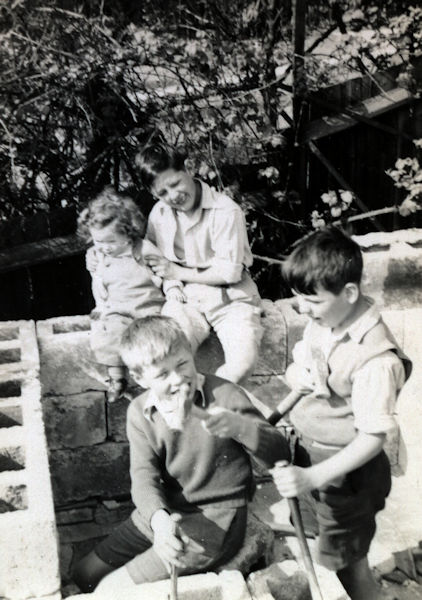
Ray, and Gordon
In 2019 I went back again and not suprisingly the city had change out of all recognition. The school had been extended and the whole area round the original building had been built up.I did not recognize it as HighFields. It had become Broadgreen International Academy. I walked back to the house, and once arcoss the road where the trams use to run , the houses looked the same and untll I got to were the shops had been, they had all been converted to houses and flats.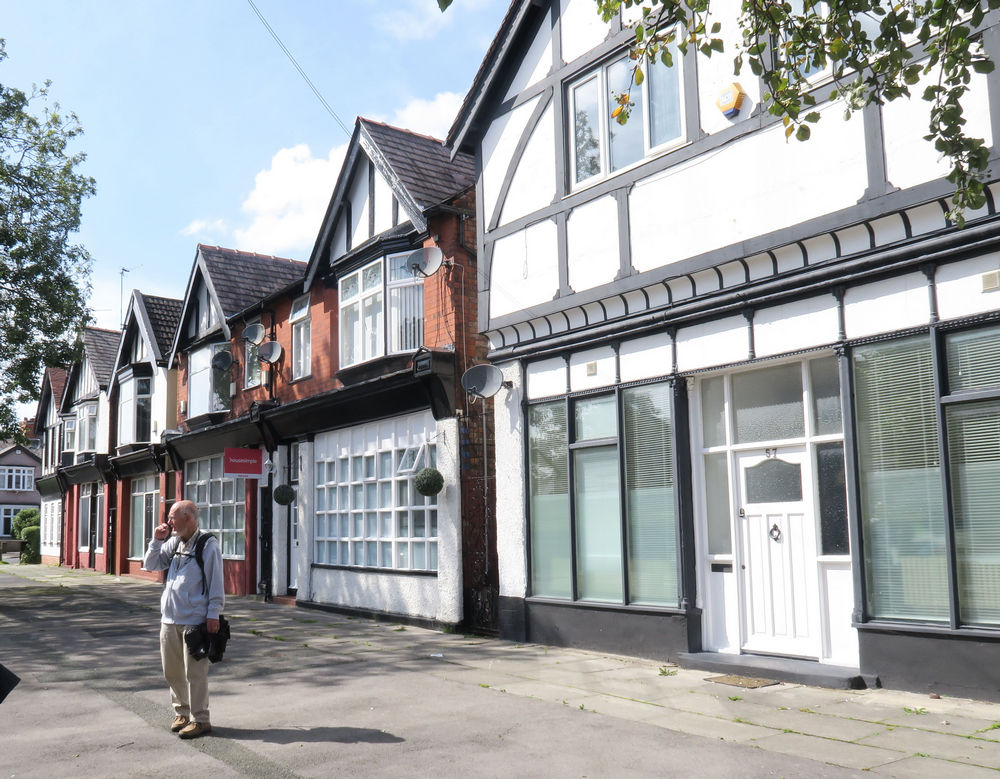
At Burnt Ash Junior school I had failed the 11+ due to the inability to spell or read well, but two years later I had another chance and passed the exam to go to Beckenham Technical school. The school was set up to cater for boys that developed later or like me had a more practical outlook. During the first year the 100 or so boys were split into 4 classes and we all shared the same subjects including French. at the end of the year we were streamed into 4 classes Engineering, Building, Art and X. The X class followed a grammar school like curriculum. So for the next two years we specialized in the appropriate subjects. Here I did quite well, studding the normal subjects but it include engineering workshop practice, and engineering drawing, the maths and science were tailored to engineering. The failure of the course was there was not a recognized exam or qualification at the end.
I had joined the Chess Club during my second year and became Secretary in my last year. My father had taught me to play when I was about 7, and I remember our white knight had lost it's base, it was a nice boxwood set in a wooden box. With the end of school in July 1949 I joined Small Electric Motors Ltd, Beckenham as office boy, with the idea that I would be taken on as a Student Apprentice. SEM sent all potential apprentices to the Imperial College of Industrial Psychology in London, for assessment, before for being selected for an apprenticeship. 1st September 1949 was the start of my Student Apprenticeship, 4 years and 250 days. Alternate weeks were spent at South East London Technical College, studying both Electrical and Mechanical subjects.
Early in 1950 walking home from the chess club I met Len Cooper, he was at Beckenham Tech a year below me and also in the Chess Club. He suggested that I should join the YWCA youth club, of which he was a member, so I did. The club was open each weekday evening, Wednesday and Friday were given over to dancing.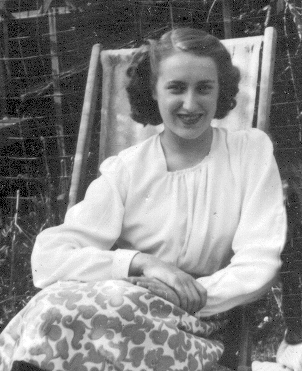
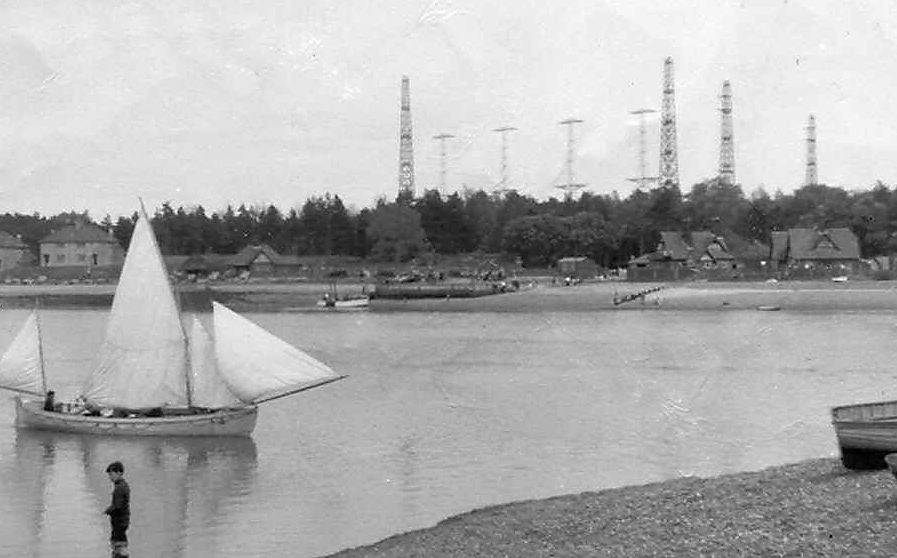
With the Aerial towers in the background.
photo by Robert Newstead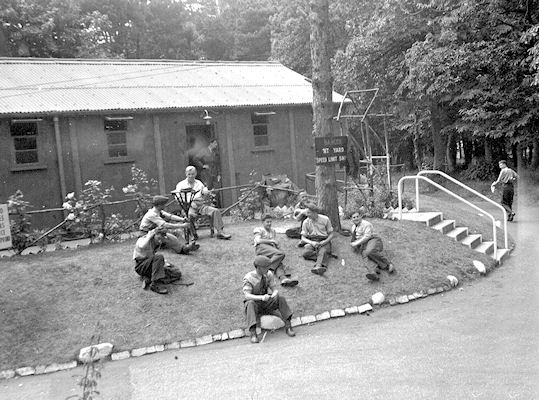
days work! The weather during 1955
was very good and we were able to
go to the beach in the lunch hour.
As an Electrical Fitter attached to the M/T section my job was largely the electrical maintenance of the vehicles but I was also given the job of carrying out safety checks on all requests for personal electrical equipment.
After my National Service I went back to SEM, but once an apprentice always an apprentice, working in the Laboratory on Dynamic Balancing Machines. Uninspiring work but useful experience, even if not apparent at the time. I also did some work on a regulated power supply, to drive the pulse load of a punched card reader. It comprised a motor generator with a valve driven field regulator and a bank of capacitors floating across the output. After about 6 months I left to take up a position with English Electric in the Instrument Division. My job was the development of Gyroscope motors. The advantage of the job was it came with a Stevenage Development Corporation house. Initially I was working on a 2 degree of freedom gyro originally designed for the V2! The basic problems were power consumption and bearing life and in the case of this gyro its susceptibility to vibration, this was a sensor problem rather than a motor problem. The gyros were hysteresis motors running at 24000 rpm: I introduced better control of the magnetic properties of the motor, so reducing the power requirement. The bearing life was subject to a very large development programme, and in general although the life was increased to 30 hours or so, it was not until I decided to enclose the motor in a helium atmosphere, to reduce the windage loss, that the bearing life improve significantly. At a stroke we were achieving a bearing life of 2 - 3 thousand hours. The reason was the exclusion of oxegen which was causing the lubrication to degrade.
By 1961 I had two children and money was short and so I changed jobs again and worked for Elliott Brothers on an airborne analogue navigation computer, writing specifications for testing the machine.
By January 1964 I started work for J Langham Thompson in Watford, later known as Ether Engineering, to work on test equipment for a classified fuse project. As a spin-off of this work, the company decided to produce a commercial version of the Automatic tester from that project. I developed this machine and called it the 'Ethermatic'.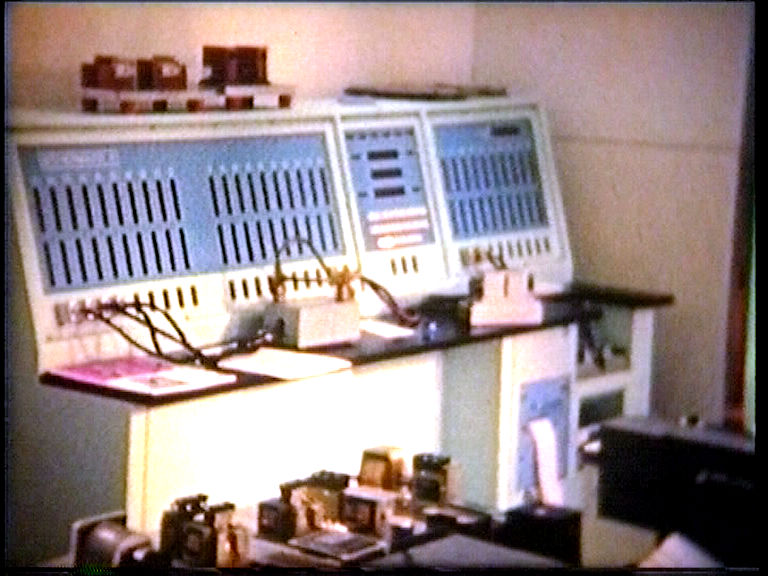
One evening in June 1969 I received a call from a friend, which resulted in a proposition being put to me involving the manufacture of a machine, to become known as the 'Carbide Hardedge'. On the 30th June 1969 Peter Loveday and I formed Aids Electronic Limited to produce the Carbide Hardedge. The machine was designed to deposit a thin layer of Tungsten Carbide to press tools to improve their life. At the end of the first year we had sold 13 machines at £280.00 each. This machine had a drawback and I subsequently developed it further, and obtained a patent in February 1972, on the improved circuit. It was then renamed 'Carbide HardedgeAutomatic'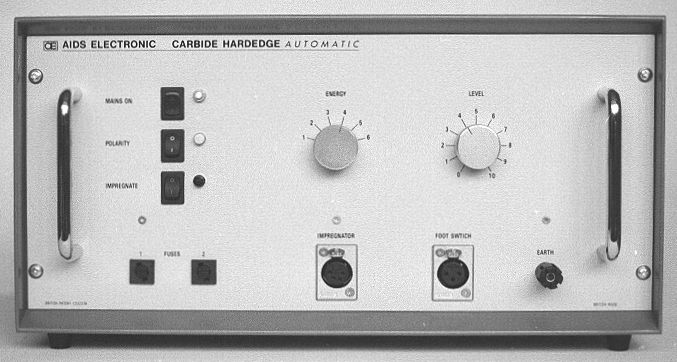
On 7th September 1970 I joined Plessey at Ilford. My job involved visiting all the company sites country wide, looking for production tasks that could benefit from mechanization or the use of automated test methods.
In 1971 we sold 24 Hardedges, 520 Electrodes and 67 Aerosols. We had made our first export sales to Holland and Sweden. By this time the whole family were involved in the manufacture of the Hardedge: the children learned to solder and assemble printed boards.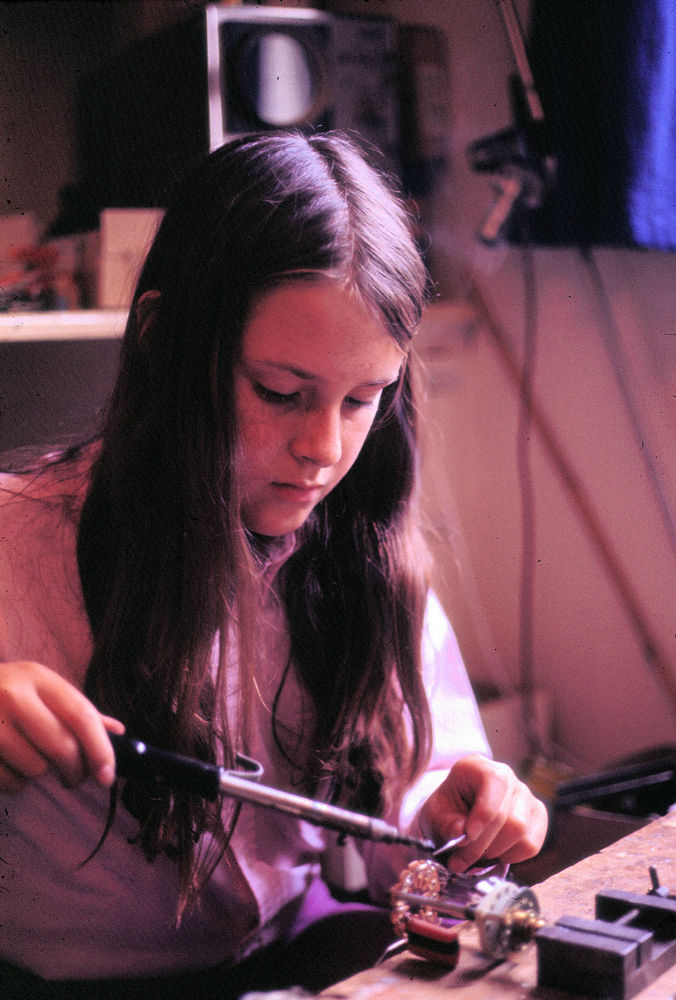
the Energy Switch
By the end of 1972 I looked for a new job, nearer home. I had enjoyed working for Plessey, but the 25-mile journey, morning and evening was a strain, especially in the winter.
During the Christmas of 1972 Peter and I decided I should work full-time for Aids Electronic and develop an Electronic Gauge System. We decided it should be as good as the market leader and as cheap as the local manufactured system. We also decided it should possible to extend it's use in automated systems. The design of the gauge head was the most challenging. I had the linear bearings made in Switzerland, no company in this country was able to produce them. After a lot of research and thought I had the had the body manufactured locally. I had settled on a maximum sensitivity of 0.001" (3µm) full scale. The gauge head had a range of greater than 0.1".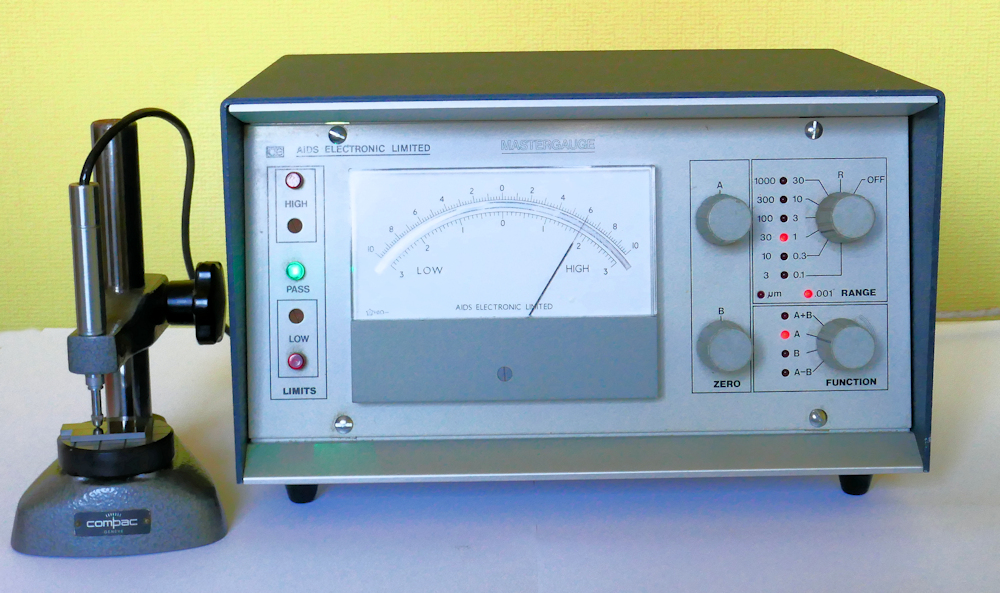
When in 1976 Peter resigned and it left me without a salesman. I talked to Norman about selling gauging, but he had his work cut out with Aids Design, so I decided to abandon the project, even though it was in pre-production.
In July 1977 I started the Sturmy Archer Project. This was a transfer press protection system. The transfer press was making 3 speed rear bicycle hubs. If a part-made hub did not locate properly in its tool the subsequent draw operation could cause damage to the tooling and jam the press. I designed a system that sensed the position of the part, and if incorrect, stopped the press before damage could occur. The technology was based on the gauging work that I had done.
In March 1978 I started the biggest project I had done to date. This was the Holset Project.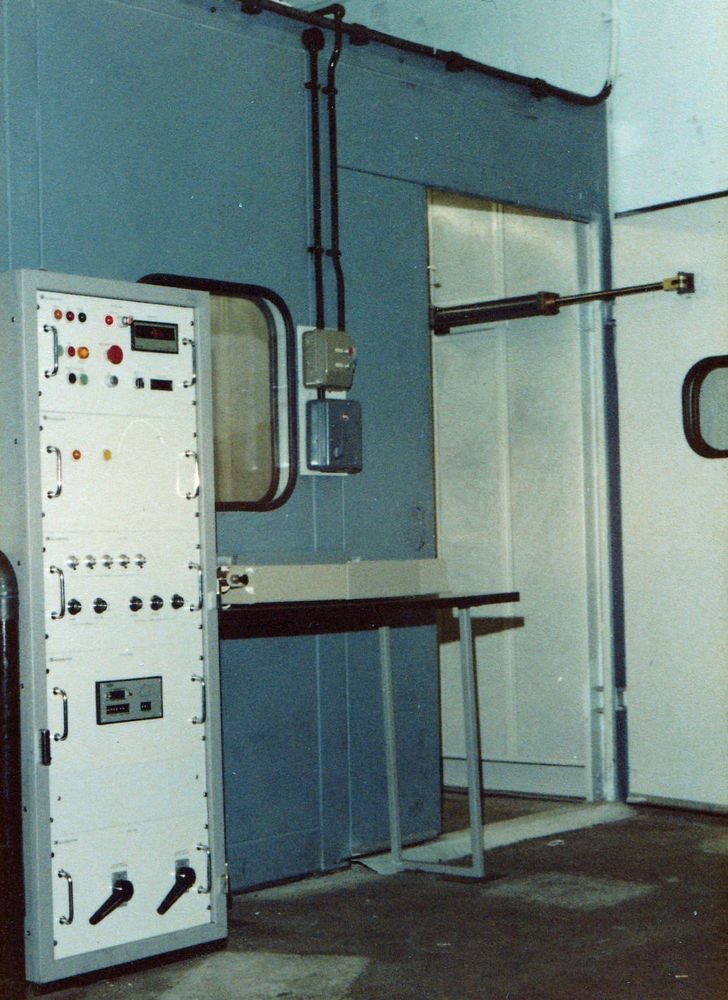
In August 1980 I formed Aids Data Systems Limited to market computers, initially the AppleII but later the PC.
My first Apple programme was for a company making Current Transformers; it designed the transformer and predicted the performance. The programme was written in Basic, and after some tweaking of the design method, it worked well, and much faster than calculating by hand. After this I did a series of programmes for both the Apple and the PC. These included
Pharmacy LabellingBy June 1981 Aids Design was having serious problems, there was very little work available due to the recession. I think that Norman was disheartened, and did not put in all the effort that was needed; he was becoming more interested computers and Computer Aided Design. At the beginning of December the decision was made to make the design staff redundant. My hope was that CAD would take off but it was the end of Aids Design and finally ceased trading in December 1984.
Payroll Programme
Asthmatic Patient Data base and analysis
Payroll, Invoice generating & printing intigrated to a standard accounts package
A Road Transport accounts & load analysis
Paper tape reader & printer to automate a Blood analysis machine
A Fan test project, like a mini Holset.
In September 1983 we got an order from Mullard for a Data Collection System for the Glass Works. I designed a minicomputer as a data terminal of which there were 10, all networked to an AppleII. The terminal was based on a 6502 processor and it had a 2 line LCD display in a steel drip proof case,
I started the Thorne-EMI data collection programme in December 1986, but the order was not obtained until 1987. It was to use an IBM PC instead of the Apple as the Server. This project was written in Turbo Pascal. The project was quite successful, but ultimately it was displaced by a new company system. The new system did not produce the same level of statistics as ours had done.
By 1988 we were selling only CAD on PCs. I wrote a Petty Cash programme, an Invoice programme, and developed the programme in to a Time and Cost Recording programme.
In April 1993 I Start on the Gallup Till project in conjunction with Herts Business Machines, This was a basic till for record shops which also collected information on record sales. The information was up load, each night, to a central server and from this the Top 20 was constructed. The programme worked well on trial, at a local Record Shop in Watford, but Gallup did not get the Top 20 contract, so no big sales.
My next project was a Care Home programme based on the TCR. Almost as soon as it is completed changes were required, because of the changing requirements of the DHSS. I did a second version for another customer but I don't think either are used to any extent. The problem was, that to work properly, all information has to be entered and kept up to date, and this they found difficult, they had been so used to working from memory or scraps of paper. As a programme I was pleased with it, it's displays were quite graphical. It also linked to a Payroll programme.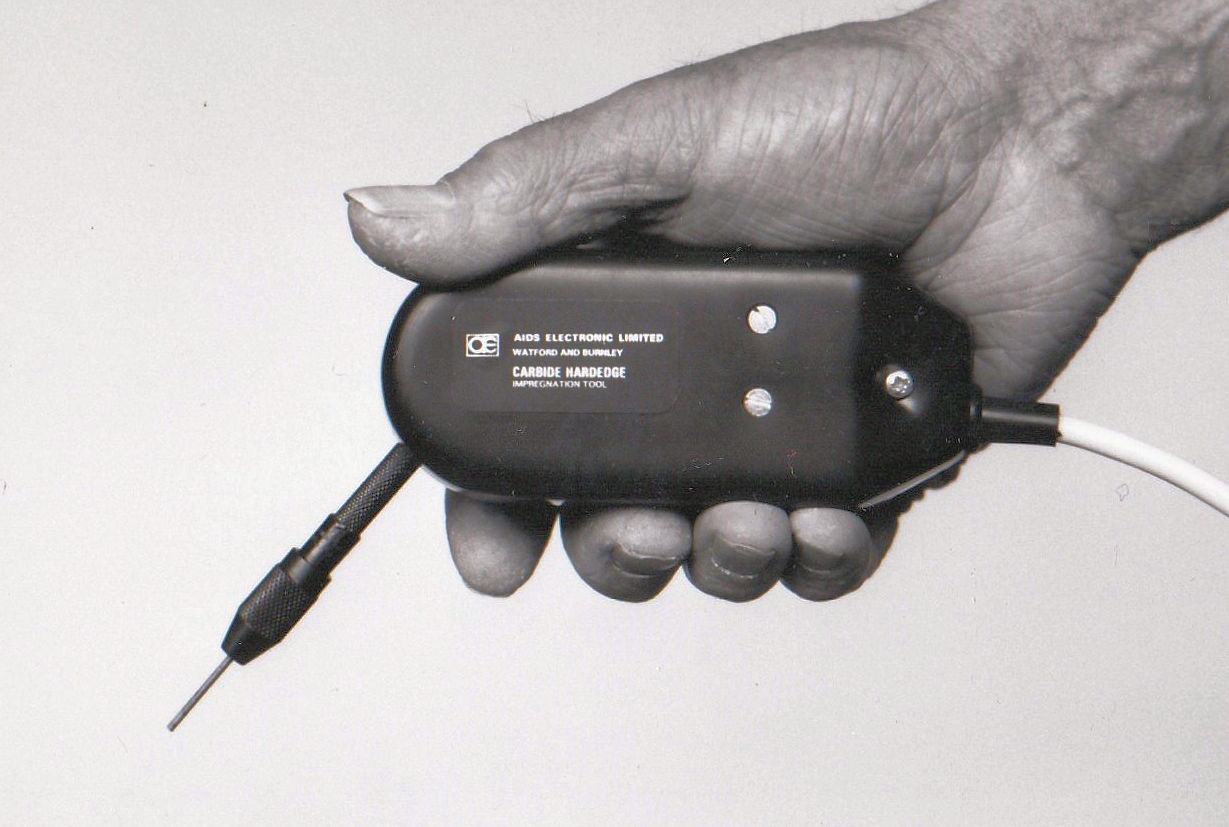
In September 1996 Norman had a serious operation, and was told he must not work for 3 months. I decided that Aids Data would not work without him and decided to finish and close Burnley.
December 1999 sees the start of my last big project, the Burkard Project. The project was basically a two dimensional A4 printer but instead of a print head it has a spray nozzle, and is to be used by the pharmaceutical industry. The controller was a small single board PC with a PC104 interface. I wrote the software in Pascal running under DOS3.3. I designed the electronics, which drives the stepper motors, and a 2 x 40 column LCD display and 6 operating keys. The company manufactured the machine both mechanically and electronically. The software uses a print file generated from a Word or Paint picture, to drive the spray head. The reproduced pattern was size for size with the original Word pattern. The software also compensated for the spray head On/Off delay time.
I sold the last Carbide Hardedge on 28th January 2001. The Hardedge total sales were about 700 units worldwide. I don't have any records of Keypads but it must have been several hundred.
The four data collection systems that were installed, had a total of about 50 stations.
In the last 25 or so years I have been working on the "Family Tree" and it now comprises of over 1200 photographs and a 130 pages of text.
I have lived most of my life without knowing whether any family survive in Russia. Then in 2018 I was contacted by Olga a decendant of Rachel's Brother, this lead to further contacts. Now I have several 2nd and 3rd cousins. Sadly Pam did not get to meet them.

